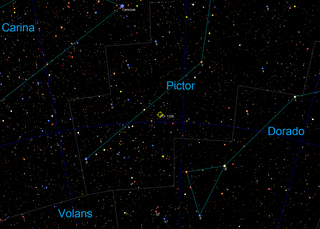TOI-1338
TOI-1338とは、地球からがか座の方向に約1,320光年離れた場所に位置する連星系である[1]。TESSにより発見された周連星惑星のTOI-1338 bが周囲を公転していることが知られている[4]。
| TOI-1338 | ||
|---|---|---|

| ||
TOI-1338の2つの恒星と周囲を公転する惑星の想像図
| ||
| 星座 | がか座 | |
| 見かけの等級 (mv) | 11.72[1] | |
| 変光星型 | 食連星[2] | |
| 分類 | 恒星 | |
| 軌道要素と性質 | ||
| 軌道長半径 (a) | 0.1321+0.0024 −0.0025 au[1] | |
| 離心率 (e) | 0.15603±0.00015[1] | |
| 公転周期 (P) | 14.608559+0.00013 −0.00012 d[1] | |
| 軌道傾斜角 (i) | 89.696+0.178 −0.114[1] | |
| 惑星の数 | 2 | |
| 位置 元期:J2000.0 | ||
| 赤経 (RA, α) | 06h 08m 31.968s[3] | |
| 赤緯 (Dec, δ) | −59° 32′ 28.08″[3] | |
| 視線速度 (Rv) | 23.56±5.34 km/s[3] | |
| 固有運動 (μ) | 赤経: −12.057 ミリ秒/年[3] 赤緯: +34.513 ミリ秒/年[3] | |
| 年周視差 (π) | 2.4752 ± 0.0099ミリ秒[3] (誤差0.4%) | |
| 距離 | 1318 ± 5 光年[注 1] (404 ± 2 パーセク[注 1]) | |
| 物理的性質 | ||
| 半径 | A:1.331+0.024 −0.026 R☉[1] B:0.3089+0.0056 −0.0060 R☉[1] | |
| 質量 | A:1.127+0.068 −0.069 M☉[1] B:0.3128+0.0113 −0.0118 M☉[1] | |
| 表面重力 | A:4.0 cgs[1] | |
| 自転速度 | A:3.6 km/s[1] | |
| 自転周期 | A:19±3 d[1] | |
| スペクトル分類 | A:F8[2] | |
| 光度 | A:2.1 L☉[3] | |
| 表面温度 | A:6,160 K[3] | |
| 金属量[Fe/H] | A:+0.01[3] | |
| 年齢 | 44 億年[3] | |
| 他のカタログでの名称 | ||
| TYC 8533-950-1, EBLM J0608-59, 2MASS J06083197-5932280, RAVE J060832.0-593228 | ||
| ■Template (■ノート ■解説) ■Project | ||

| 太陽 | TOI-1338 A |
|---|---|

|

|
| 太陽 | TOI-1338 B |
|---|---|

|
名称と歴史 編集
「TOI」とは、「TESS Objects of Interest」の略である。惑星TOI-1338 bは2019年の夏に、当時ニューヨークのスカースデイル高校に通っていた17歳のWolf Cukierによって発見された。彼はゴダード宇宙飛行センターに夏のインターンとして参加し[5]、プラネットハンターズ市民科学プロジェクトのボランティアによって食連星としてフラグが立てられた光度曲線を調査した[6]。Cukierと6人のプラネットハンターズのボランティアは、新たに発見された惑星に関する出版物の共著者である[1]。Cukierは現在、宇宙物理学科の学部生としてプリンストン大学に通っている[7]。
Cukierは惑星に名前を付ける機会を与えられなかった[8]。2021年2月、惑星TOI-1338 bを「SOPHIE」と命名するよう求める嘆願書には、90,000を超える署名が寄せられた[9]。嘆願書の主催者は、2021年1月30日に亡くなったミュージシャン兼音楽プロデューサーのソフィーに敬意を表そうとした[10]。キャンペーンの著名な支持者には、チャーリー・XCXとキャロライン・ポラチェックが含まれていた[9]。
連星 編集
TOI-1338は、スペクトル分類がF8の恒星とMの恒星(赤色矮星)からなる単線分光連星系である。年齢は約44億年とされている。質量が1.13太陽質量と0.313太陽質量の2つの恒星は、14.6日ごとに互いの周囲を公転している。赤色矮星は、主星よりも約9等暗く、スペクトルでは検出できない[11][1]。
2つの恒星の軌道は89.7°傾いており、明るさの変化は非常に小さいものの、主星と伴星の両方が観測できる。高温の主星が低温の伴星によって部分的に遮られた場合、これは約5時間続き、明るさは約4%低下する。低温の伴星が高温の主星によって遮られる場合、これも約5時間続くが、明るさの低下は0.5%未満である[1]。
惑星系 編集
太陽系外惑星 TOI-1338 b は、海王星と土星の中間の大きさを持ち、連星と同一平面内で~1°以内の軌道を持っている[1]。主星の自転も、連星と惑星の軌道と一致する(赤道傾斜角 β = 2.8±17.1 °)。ロシター・マクローリン効果が周連星惑星を持つ恒星に対して測定されたのはこれが2回目である。ケプラー16は、このような測定を行った最初の惑星系であった。TOI-1338のアラインメントの測定は、惑星が単一の周連星円盤から形成されたことを示唆している[12]。
2023年には、ドップラー分光法により2番目の周連星惑星 TOI-1338 c が発見された。この惑星は約215.5日の公転周期を持ち、高精度視線速度系外惑星探査装置(HARPS)とESPRESSOによって発見された。TOI-1338 cはドップラー分光法のみを用いて発見された最初の周連星惑星である[13]。
| 名称 (恒星に近い順) |
質量 | 軌道長半径 (天文単位) |
公転周期 (日) |
軌道離心率 | 軌道傾斜角 | 半径 |
|---|---|---|---|---|---|---|
| b | 33.0±20.0 M⊕ | 0.4607+0.0084 −0.0088 |
95.174+0.031 −0.035 |
0.0880+0.0043 −0.0033 |
89.37+0.35 −0.26° |
6.85±0.19 R⊕ |
| c | 65.2±11.8 M⊕ | 0.794±0.016 | 215.5±3.3 | <0.16 | — | — |
脚注 編集
注釈 編集
出典 編集
- ^ a b c d e f g h i j k l m n o p q r Kostov, Veselin B.; Orosz, Jerome A.; Feinstein, Adina D.; Welsh, William F.; Cukier, Wolf; Haghighipour, Nader; Quarles, Billy; Martin, David V. et al. (2020-05-07). “TOI-1338: TESS' First Transiting Circumbinary Planet”. The Astronomical Journal 159 (6): 253. arXiv:2004.07783. Bibcode: 2020AJ....159..253K. doi:10.3847/1538-3881/ab8a48. hdl:10023/20067. ISSN 1538-3881.
- ^ a b Triaud, Amaury H. M. J.; Martin, David V.; Ségransan, Damien; Smalley, Barry; Maxted, Pierre F. L.; Anderson, David R.; Bouchy, François; Collier Cameron, Andrew et al. (2017). “The EBLM Project. IV. Spectroscopic orbits of over 100 eclipsing M dwarfs masquerading as transiting hot Jupiters”. Astronomy and Astrophysics 608: A129. arXiv:1707.07521. Bibcode: 2017A&A...608A.129T. doi:10.1051/0004-6361/201730993.
- ^ a b c d e f g h i j Vallenari, A. et al. (2022). “Gaia Data Release 3. Summary of the content and survey properties”. Astronomy & Astrophysics. arXiv:2208.00211. doi:10.1051/0004-6361/202243940 Gaia DR3 record for this source at VizieR.
- ^ “ExoFOP TIC 260128333”. exofop.ipac.caltech.edu. 2020年1月9日閲覧。
- ^ Pereira, Ivan (2020年1月9日). “New York teen discovers new planet while interning with NASA”. ABC News
- ^ “Discovery Alert! High School Student Finds a World With Two Suns”. Exoplanet Exploration: Planets Beyond our Solar System. 2020年2月14日閲覧。
- ^ “Wolf Cukier - Department of Astrophysical Sciences”. Princeton Edu. © 2022 The Trustees of Princeton University. 2022年11月6日閲覧。
- ^ Morrison, Hannah (2020年1月16日). “Meet the NASA intern who discovered a new planet on his third day”. BBC News (London, England) 2021年10月3日閲覧。
- ^ a b “SOPHIE fans call for NASA to name a planet after the late musician”. Dazed (2021年2月3日). 2021年2月4日閲覧。
- ^ Richards, Will (2021年1月30日). “DJ and producer SOPHIE has died”. NME. オリジナルの2021年1月30日時点におけるアーカイブ。 2021年1月31日閲覧。
- ^ Martin, David V.; Triaud, Amaury H. M. J.; Udry, Stephane; Marmier, Maxime; Maxted, Pierre F. L.; Cameron, Andrew Collier; Hellier, Coel; Pepe, Francesco et al. (April 2019). “The BEBOP radial-velocity survey for circumbinary planets I. Eight years of CORALIE observations of 47 single-line eclipsing binaries and abundance constraints on the masses of circumbinary planets”. Astronomy & Astrophysics 624: A68. arXiv:1901.01627. Bibcode: 2019A&A...624A..68M. doi:10.1051/0004-6361/201833669. ISSN 0004-6361.
- ^ Kunovac Hodzic, Vedad; Triaud, Amaury H. M. J.; Martin, David V.; Fabrycky, Daniel C.; Cegla, Heather M.; Collier Cameron, Andrew; Gill, Samuel; Hellier, Coel et al. (2020-07-01). “The EBLM project - VII. Spin-orbit alignment for the circumbinary planet host EBLM J0608-59 A/TOI-1338 A”. Monthly Notices of the Royal Astronomical Society 497 (2): 1627–1633. arXiv:2007.05514. Bibcode: 2020MNRAS.497.1627K. doi:10.1093/mnras/staa2071.
- ^ a b The First Circumbinary Planet Discovered with Radial Velocities, (2023), arXiv:2301.10794